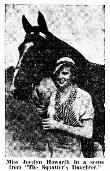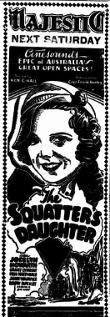AustLit
 867738768721345804.jpg
867738768721345804.jpg
Latest Issues
AbstractHistoryArchive Description
Although based on the 1905 play by Bert Bailey and Edmund Duggan (which was itself more faithfully adapted for film in 1910), this cinematic version retains little of the original. The storyline begins with Joan Enderby about to lose her family's sheep station because she can't afford to buy out the lease from her neighbours, the Sherringtons. To make matters worse, the elderly 'Ironbark' Sherrington, the owner of 'Waratah,' has been in England for two years allowing his villainous son Clive to try and remove Joan from the property. His attempt to bankrupt her is foiled, however, when a mysterious stranger offers to buy three thousand head of sheep from her at a good price. What she doesn't know is that the stranger, Wayne Ridgeway, is also rightful heir to the Sherrington estate. The only person who knows Ridgeway's identity is an Afghan trader called Jebal Zim, but he is murdered by Clive's overseer before he can tell the recently returned Ironbark Sherrington. Typical of the melodrama genre, the story's climax is played out in a thrilling scene - a bushfire - as Joan and Ridgeway try to deliver three thousand sheep to the market. After escaping the fire, they rescue Zim's kidnapped daughter, Zena and capture the overseer, Fletcher. Naturally Ridgeway is restored to his rightful inheritance, and he and Joan marry.
[Source: Australian Screen]
Publication Details of Only Known VersionEarliest 2 Known Versions of
Works about this Work
-
The Polysemous Coathanger : The Sydney Harbour Bridge in Feature Film, 1930-1982
2006
single work
criticism
— Appears in: Senses of Cinema , July - September no. 40 2006; 'The cinema has long been attracted to photographing great cultural icons. This article provides a thorough account of the celluloid life of one of Australia's most distinctive landmarks.' (Publisher's abstract)
-
y
 Sheep and the Australian Cinema
Carlton
:
Melbourne University Publishing
,
2006
Z1280812
2006
single work
criticism
'The book focuses on two key 'sheep films' The Squatters Daughter (1933) and Bitter Springs (1950). Both movies are concerned with the national project, in which sheep growing and nation building are seamlessly aligned.' Source: Back cover of Sheep and the Australian Cinema (2006).
Sheep and the Australian Cinema
Carlton
:
Melbourne University Publishing
,
2006
Z1280812
2006
single work
criticism
'The book focuses on two key 'sheep films' The Squatters Daughter (1933) and Bitter Springs (1950). Both movies are concerned with the national project, in which sheep growing and nation building are seamlessly aligned.' Source: Back cover of Sheep and the Australian Cinema (2006).
-
More Australian than Aristotelian : The Australian Bushranger Film, 1904-1914
2002
single work
criticism
— Appears in: Senses of Cinema , January-February no. 18 2002;This analysis of The Story of the Kelly Gang, Thunderbolt, and The Squatter's Daughter considers early Australian films in the light of American cowboy films, arguing that 'it is the contention of this paper that these relations are the result of certain cultural coincidences between Australia and the Western United States rather than the outcome of direct influence of the one upon the other. Viewed in this light, “the American cinema par excellence” can perhaps be more reasonably understood as the epitome of a global cinema – not an original myth of nationhood, but a story of no-place retold everywhere and at all times, even in terra nullius itself.'
-
"The Squatter's Daughter" Depicts Typical Australian Life
1933
single work
column
— Appears in: The Australian Women's Weekly , 30 September vol. 1 no. 17 1933; (p. 32) 'Undulating plains and the delicate tracery of bush trees silhouetted against the skyline, the droving of sheep in the open country and the shearing in the sheds, the humor so characteristic of the Australian bushman, and the tragedy that is ever in the offing, are vividly portrayed in The Squatter's Daughter. A desperate fight against the encroaching, consuming bush fire, and the luxury of a gorgeous swimming pool, followed by an hilarious dance at "Waratah," present a striking contrast typical of the extremes of life outback.' (p. 32)
-
A Few Stolen Moments with "The Squatter's Daughter" : Behind the Scenes with Our New Screen Beauty
1933
single work
column
— Appears in: The Australian Women's Weekly , 10 June vol. 1 no. 1 1933; (p. 33)
-
Shadow Shows
1933
single work
review
— Appears in: The Bulletin , 4 October vol. 54 no. 2799 1933; (p. 18)
— Review of The Squatter's Daughter 1933 single work film/TV -
y
 Sheep and the Australian Cinema
Carlton
:
Melbourne University Publishing
,
2006
Z1280812
2006
single work
criticism
'The book focuses on two key 'sheep films' The Squatters Daughter (1933) and Bitter Springs (1950). Both movies are concerned with the national project, in which sheep growing and nation building are seamlessly aligned.' Source: Back cover of Sheep and the Australian Cinema (2006).
Sheep and the Australian Cinema
Carlton
:
Melbourne University Publishing
,
2006
Z1280812
2006
single work
criticism
'The book focuses on two key 'sheep films' The Squatters Daughter (1933) and Bitter Springs (1950). Both movies are concerned with the national project, in which sheep growing and nation building are seamlessly aligned.' Source: Back cover of Sheep and the Australian Cinema (2006).
-
The Polysemous Coathanger : The Sydney Harbour Bridge in Feature Film, 1930-1982
2006
single work
criticism
— Appears in: Senses of Cinema , July - September no. 40 2006; 'The cinema has long been attracted to photographing great cultural icons. This article provides a thorough account of the celluloid life of one of Australia's most distinctive landmarks.' (Publisher's abstract)
-
A Few Stolen Moments with "The Squatter's Daughter" : Behind the Scenes with Our New Screen Beauty
1933
single work
column
— Appears in: The Australian Women's Weekly , 10 June vol. 1 no. 1 1933; (p. 33) -
"The Squatter's Daughter" Depicts Typical Australian Life
1933
single work
column
— Appears in: The Australian Women's Weekly , 30 September vol. 1 no. 17 1933; (p. 32) 'Undulating plains and the delicate tracery of bush trees silhouetted against the skyline, the droving of sheep in the open country and the shearing in the sheds, the humor so characteristic of the Australian bushman, and the tragedy that is ever in the offing, are vividly portrayed in The Squatter's Daughter. A desperate fight against the encroaching, consuming bush fire, and the luxury of a gorgeous swimming pool, followed by an hilarious dance at "Waratah," present a striking contrast typical of the extremes of life outback.' (p. 32)
-
More Australian than Aristotelian : The Australian Bushranger Film, 1904-1914
2002
single work
criticism
— Appears in: Senses of Cinema , January-February no. 18 2002;This analysis of The Story of the Kelly Gang, Thunderbolt, and The Squatter's Daughter considers early Australian films in the light of American cowboy films, arguing that 'it is the contention of this paper that these relations are the result of certain cultural coincidences between Australia and the Western United States rather than the outcome of direct influence of the one upon the other. Viewed in this light, “the American cinema par excellence” can perhaps be more reasonably understood as the epitome of a global cinema – not an original myth of nationhood, but a story of no-place retold everywhere and at all times, even in terra nullius itself.'
- Bush,
- Australian Outback, Central Australia,



